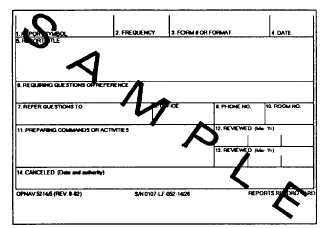| |
digits, 93, indicate the calendar year the report was
established and the next two digits, 36, reflect the next
consecutive number for one-time reports controlled for
that year. The figure 9336 in the example indicates that
this is the 36th one-time report assigned in calendar year
1993.
It is important to note that, although similar in
nature, report control symbols and forms identification
codes are separate entities. Even though the originator
and subject identification code of both maybe the same,
the consecutive number in each may not coincide. The
same holds true for the relationship between the report
and its requiring directive.
report should be filed in a report case file. Every folder
should contain the following documents
A copy of completed Report Analysis Data,
OPNAV Form 5214/10 (figs. 6-2A and 6-2B
A copy of the report form, format, or a copy of
the report
A copy of the document requiring the report
Related papers, such as source records, analyses,
surveys, and memos, pertaining to the report
Folders within the case file should be arranged
chronologically by report control symbol.
INVENTORY OF REPORTS
FOLLOW-UP PROCEDURES
An accurate and current inventory of recurring
reports is essential for effective operation and is
maintained by the reports control manager. A case folder
must be maintained on all reports for which your activity
has cognizance. The Reports Record Card, OPNAV
5214/5 (fig. 6-1), may be used to establish a manual
inventory system or an automated management data
fields system may be obtained from the
COMNAVDAC.
A close working relationship with the directives
control point, forms manager, mail room, publications
review office, and other points or individuals within the
command who may be aware of new or revised reports
requirements will help greatly in your efforts.
ESTABLISHMENT AND
MAINTENANCE OF RECORDS
After all recurring reports have been inventoried
and classified by a report symbol, one folder for each
Figure 6-1.-Reports Record Card, OPNAV 5214/5.
Established reports required by the command must
be given follow-up review to determine whether they
continue to be needed and, if so, whether they continue
to meet all the requirements in the most effective reamer
in light of changing needs and situations, relationship to
other reports, possible consolidations, and new
developments in reporting devices and techniques.
A report must be reviewed before its expiration to
determine if it continues to meet requirements
efficiently. This review is done by the report originator
60 days before the third anniversary of the
administrative issuance requiring the report to include
complete rejustification of the requirement. Reports not
approved for extension are automatically canceled on
the third anniversary date and are omitted from any
subsequent effective reports listing.
Possibly the most effective way to provide an
annual review of every report required by your
command is to combine the reviews with the annual
review of command directives. Since each required
report has a command directive as its basis, a complete
review of that directive 3 months before the anniversary
month of its issue date would provide the opportunity
for an in-depth look at any report listed therein. (This is
also an excellent time to accomplish a review of the local
forms used for these reports. See chapter 5.)
In accomplishing this review, a copy of the report
form and a blank OPNAV Form 5214/10 covering the
report would be provided to the reviewing office along
with the applicable directive. A decision to modify,
cancel, or continue the existing directive would,
likewise, contain a similar decision concerning any
report or form required by the directive.
6-3
|

